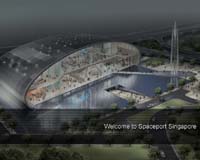| . |  |
. |
Upton NY (SPX) Feb 21, 2006 Research suggests proton radiation may be more damaging to the DNA of astronauts than previously thought, meaning engineers will have to pay more attention to the potential hazards of protons when designing spacecraft intended to travel deeper into the solar system. "Scientists have been assuming that protons damage cells in a way similar to X-rays, but our results indicate that these assumptions have been wrong," said lead researcher Betsy Sutherland, with NASA's Space Radiation Laboratory on Long Island. "The new data show that protons produce more potentially lethal double-strand breaks, a type of severe DNA damage, than other kinds of DNA damages," Sutherland said. "This means that scientists don't really know how human DNA is affected by the most numerous particles in space and, as a result, do not know how to design the proper protection for astronauts." Of the various radiation types, protons, like X-rays and gamma rays, are classified as low linear energy transfer, or LET, radiation, meaning they do not lose much energy as they pass through matter. Therefore, scientists have assumed protons would damage biological systems in the same way, but Sutherland and her colleague Megumi Hada discovered that protons produced a spectrum of cellular damage very similar to the pattern caused by high-energy iron ions and other heavy charged particles. Reporting in the February 2006 edition of the journal Radiation Research, Sutherland and Hada said they investigated the levels and kinds of multiple damages, called damage clusters, produced by high-energy radiation beams. Damage clusters are dangerous because they can cause genetic mutations and cancers, or they can be converted to double-strand breaks. The researchers used beams of high-energy charged particles (protons, as well as iron, carbon, titanium, and silicon ions) and exposed DNA in solution to each type of radiation. They then measured the levels of three kinds of damage clusters, as well as double-strand breaks produced as a result of the exposure. Because these clusters and double-strand breaks may have different effects on human cells, it is essential to know how many of each kind are produced by the radiation an astronaut would encounter. "Our study shows that we need to re-evaluate the effect of protons on biological systems, even the effects of low-energy protons," Sutherland said. "For example, low-energy protons are routinely used in cancer-tumor therapy, but there has been almost no research done on the effect of protons in tumor cells because everyone has assumed that they act similarly to other low LET radiation types, like x-rays. Therefore, this work may help lead to improved cancer therapy." Sutherland said her group is extending the research to human cells irradiated with the same beams. They think this will help them more accurately predict the effects of radiation on human cells and tissue. Related Links Brookhaven NASA Space Radiation Laboratory
 Arlington VA (SPX) Feb 21, 2006
Arlington VA (SPX) Feb 21, 2006 Space Adventures Ltd. said Monday it plans to develop an integrated spaceport in Singapore that will offer sub-orbital spaceflights and operate astronaut training facilities and a public education and interactive visitor center. |
|
| The content herein, unless otherwise known to be public domain, are Copyright 1995-2006 - SpaceDaily.AFP and UPI Wire Stories are copyright Agence France-Presse and United Press International. ESA PortalReports are copyright European Space Agency. All NASA sourced material is public domain. Additionalcopyrights may apply in whole or part to other bona fide parties. Advertising does not imply endorsement,agreement or approval of any opinions, statements or information provided by SpaceDaily on any Web page published or hosted by SpaceDaily. Privacy Statement |